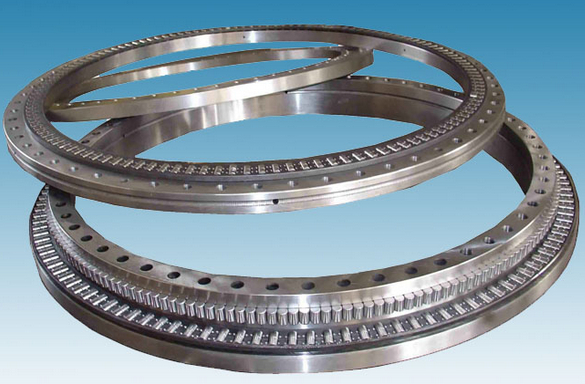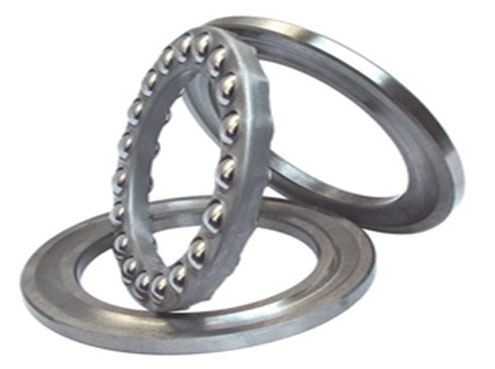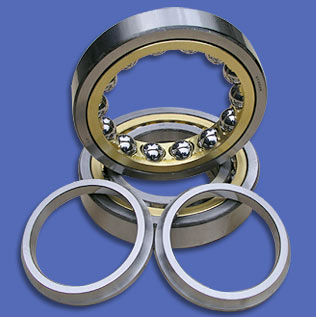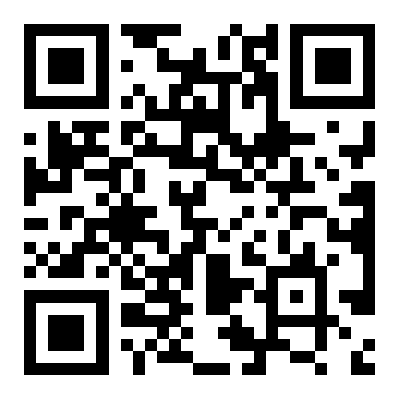Thrust ball bearings include unidirectional thrust ball bearings, bidirectional thrust ball bearings, and angular contact thrust ball bearings according to their different structures.
Unidirectional thrust ball bearings can withstand axial loads in one direction, but cannot withstand radial loads. Able to perform unidirectional axial positioning.
Unidirectional thrust ball bearings can be divided into flat race and self-aligning race. Generally, angle errors are not allowed for flat seat rings, but in support design, a gap of 0.5 to 1mm can be left between the outer diameter of the seat ring and the mating surface of the bearing seat for compensation. Thrust ball bearings with centering seats can also be used to compensate for angle errors that occur during installation. But the centering seat needs to be ordered separately.
Bidirectional thrust ball bearings can withstand axial loads in both directions. But it cannot withstand radial loads. Can perform axial positioning in two directions.
Bidirectional thrust ball bearings can also be divided into flat seat rings and self-aligning seat rings. Generally, angle errors are not allowed for flat seat rings, but in support design, a gap of 0.5 to 1mm can be left between the outer diameter of the seat ring and the mating surface of the bearing seat for compensation. Thrust ball bearings with centering seats can also be used to compensate for angle errors during installation. But the centering seat needs to be ordered separately.
Angular contact thrust ball bearings mainly bear axial loads and can also withstand a small amount of radial loads.
Compared with thrust ball bearings of the same size, the allowable limit speed is higher. Able to perform unidirectional axial positioning.
There are two types of contact angles for angular contact thrust ball bearings: 45 ° and 60 °, which are particularly suitable for applications where axial loads are the main bearing and composite loads with a certain radial load are present. It can also compensate for the shortage of planar thrust ball bearings that can only withstand axial loads and cannot withstand radial loads. The size of the radial load that this structure can withstand depends on the size of the contact angle. Generally speaking, the smaller the contact angle, the greater its ability to withstand radial loads.
The structure of thrust ball bearings with outer covers is basically the same as that of unidirectional thrust ball bearings. But wear an outer cover on the seat ring (or both inner and outer diameters of the seat ring). Due to the outer cover, the thrust ball bearing with the outer cover becomes an inseparable bearing, and the function of the outer cover is to prevent dust. The structure shown can also be filled with lubricating grease.
Thrust ball bearings with covers can withstand axial loads in one direction, but cannot withstand radial loads. Able to perform unidirectional axial positioning.
Other structural forms of thrust ball bearings can also be provided, such as non cage thrust ball bearings, tapered hole one-way thrust ball bearings, steel wire raceway one-way thrust ball bearings, and various other products.
The cage of thrust ball bearings generally adopts steel plate stamped cages, as well as vehicle made steel, brass solid cages, and engineering plastic cages such as glass fiber reinforced nylon 66.
In order to ensure good operation of bearings, thrust ball bearings, like other ball and roller bearings, must apply a certain amount of minimum load, especially for high-speed, high acceleration, or working under conditions with frequent changes in load direction. Because of these operating conditions, the inertia force between the ball and the cage, as well as the friction inside the lubricant, will have a negative impact on the rolling and rotating accuracy of the bearing, and there may be harmful sliding motion between the ball and the raceway that is harmful to the bearing.
Starting at low temperatures or with high lubricant viscosity may require a larger minimum load. Usually, the weight of the bearing support itself, combined with the load borne by the bearing, has exceeded the minimum required load. If the minimum load has not been reached, the structural bearing must apply additional axial load to meet the minimum load requirements. In the application of thrust ball bearings, springs, etc. can generally be used to apply axial preload.
Dimensions, tolerances
The external dimensions of standard thrust ball bearings comply with the provisions of GB/T273.2 "General Plan for External Dimensions of Rolling Bearings and Thrust Bearings" and GB/T301 "External Dimensions of Rolling Bearings and Thrust Ball Bearings".
The tolerance of standard thrust ball bearings shall comply with the provisions of GB/T307.4 "Rolling Bearings, Thrust Bearings, Tolerances", etc.
Equivalent dynamic load
For thrust ball bearings that bear dynamic loads, the equivalent dynamic load can be calculated using the following method:
α= 90 ° P=Fa
α≠ 90 ° P=XFr+YFa
Unidirectional bearing
When α= 45 °
Fa/Fr>e X=0.66 Y=1 e=1.25
When α= 60 °
Fa/Fr>e X=0.92 Y=1 e=2.17
Bidirectional bearing
When α= 45 °
Fa/Fr>e X=0.66 Y=1 e=1.25
Fa/Fr ≤ e X=1.18 Y=0.59 e=1.25
When α= 60 °
Fa/Fr>e X=0.92 Y=1 e=1.25
Fa/Fr ≤ e X=1.9 Y=0.55 e=2.17
For thrust ball bearings that bear static loads, the equivalent static load can be calculated using the following method:
α= 90 ° P0=Fa
α≠ 90 ° P0=Fa+2.3Fr · tan α
In the equation
Fa - Radial load, N
Fr - Axial load, N
α - contact angle
X-radial load coefficient
Y-axial load coefficient





